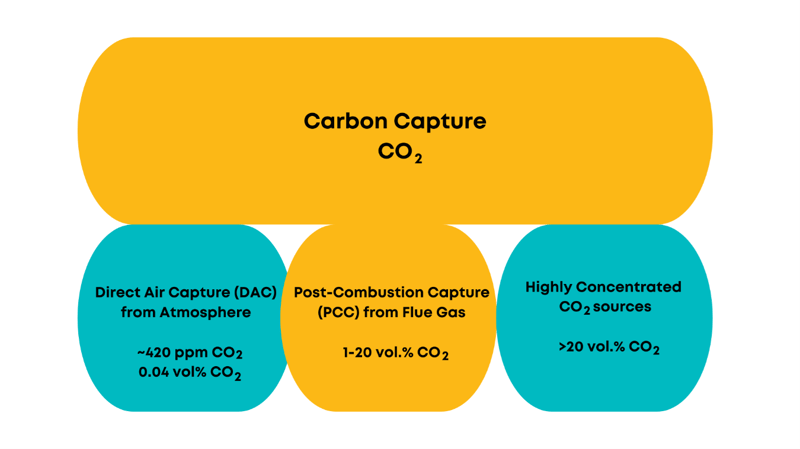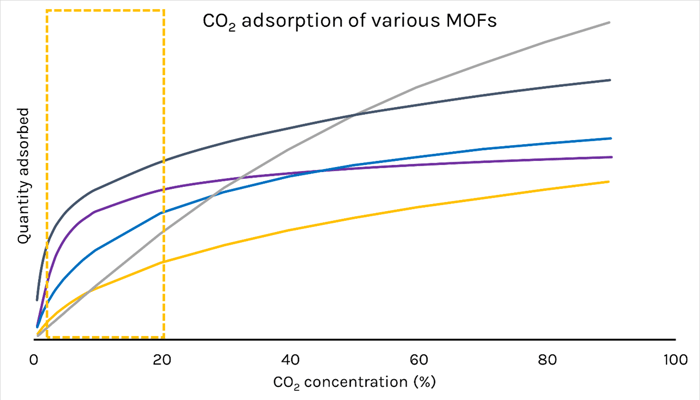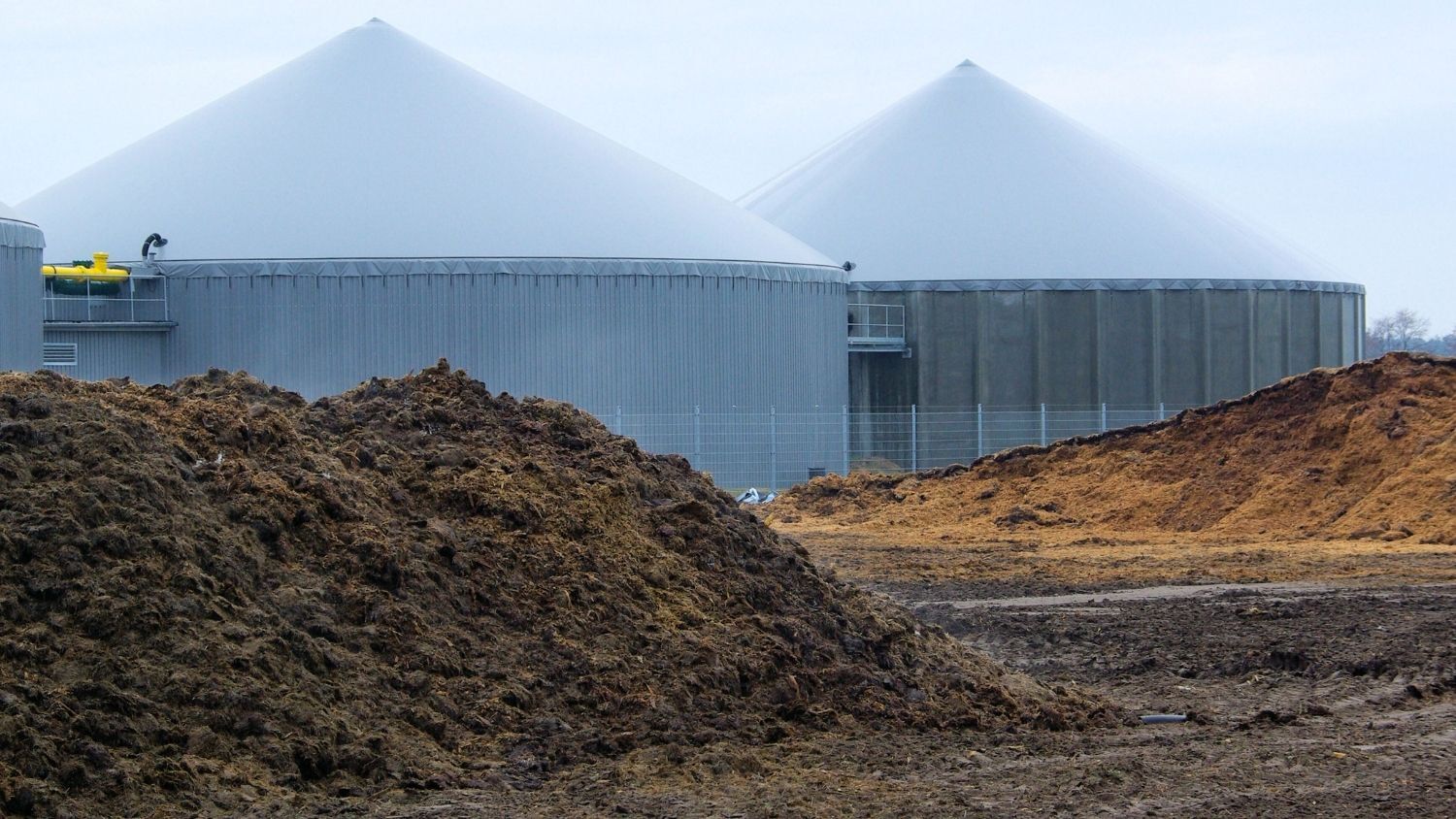Whilst global energy needs increase year after year and the quest for sustainable energy solutions is more pressing than ever, carbon capture technologies have emerged as indispensable tools in the fight against climate change. Traditional methods for carbon capture such as amine scrubbing are effective but energy-intensive and costly. As an emerging technology platform, the utilization of Metal-Organic Frameworks (MOFs) presents a revolutionary approach with the potential to significantly impact emissions reduction across various industries.
Carbon Capture Technologies
Carbon capture can be categorized into three categories based on CO2 concentration:
- Direct Air Capture at 420 ppm or 0.04 vol.% CO2
- Post-combustion capture ranging between 1-20 vol.% CO2
- Highly concentrated CO2 sources (biogas upgrading, steel production, etc.) with >20 vol.% CO2

Finding the Sweet Spot for MOF-based Adsorption
MOFs are crystalline materials consisting of metal ions or clusters connected by organic ligands, forming porous microstructures with high surface areas. MOFs present an attractive alternative due to their high selectivity, tunable pore structures, and low energy requirements for regeneration.
The key to unlocking the full potential of MOFs for carbon capture lies in optimizing their properties to achieve the perfect balance between capacity, selectivity, and stability. Some strategies to tailor MOFs for enhanced CO2 adsorption include:
Operational conditions for MOF-based systems vary depending on the specific application and the chosen adsorption process. MOFs have demonstrated effectiveness across a range of temperature, pressure, and CO2 concentration conditions. For instance, they have been successfully utilized in various adsorption processes such as Temperature Swing Adsorption (TSA), Pressure Swing Adsorption (PSA), Vacuum Pressure Swing Adsorption (VPSA), and Temperature and Vacuum Swing Adsorption (TVSA). The table below shows typical conditions used in the above adsorption methods:
These processes allow for tailored adjustments in operating conditions to achieve optimal performance. It's essential to consider the suitability of MOFs across different processes and conditions to maximize their effectiveness in CO2 capture applications.
Stability and Regeneration: Ensuring the long-term stability and recyclability of MOFs is crucial for practical applications. MOFs with robust frameworks can withstand harsh operating conditions, such as high temperatures and chemical exposure. Additionally, designing MOFs with facile regeneration pathways enables efficient desorption and regeneration, minimizing energy consumption and operational costs.
Functionalization: Introducing functional groups into MOF structures can enhance affinity and selectivity towards CO2. Functionalization allows the chemical interactions between the MOF surface and other molecules to be fine-tuned, leading to enhanced adsorption properties. Common functional groups include amino, hydroxyl, and carboxyl groups, which can form strong interactions with CO2 via chemisorption or physisorption mechanisms.
Pore Size Engineering: Controlling the size and geometry of pores within MOFs is crucial for maximizing carbon dioxide uptake. By precisely controlling the dimensions of the pores, researchers can optimize the adsorption capacity while minimizing diffusion limitations. Recent advancements in synthetic techniques have enabled the design of MOFs with tailored pore architectures, leading to significant improvements in carbon capture performance.
Stability and Regeneration: Ensuring the long-term stability and recyclability of MOFs is crucial for practical applications. MOFs with robust frameworks can withstand harsh operating conditions, such as high temperatures and chemical exposure. Additionally, designing MOFs with facile regeneration pathways enables efficient desorption and regeneration, minimizing energy consumption and operational costs.

Success Story of MOF-Based Adsorption Technology
Recent academic and industrial research has demonstrated the ability of MOF-based adsorption technology to capture CO2 from low-to-moderate concentration sources ranging from 1% to 20%, making MOFs particularly well-suited for capturing carbon dioxide from flue gases emitted by industrial processes such as aluminium or cement production as well as the power generation industry. MOFs' selective adsorption properties allow for efficient capture of CO2 even in the presence of other gases, ensuring high purity of captured carbon dioxide for storage or utilization.


This successful example of applying the unique tunable properties of MOFs to a specific range of CO2 concentrations demonstrates the potential of MOFs to rise to the challenges posed by our need to combat climate change and reduce carbon emissions. In addition to their efficient capture of CO2 from low-to-moderate concentration streams, with their unique properties and versatility, MOFs offer a promising solution for emissions reduction across various industries such as biogas upgrading, natural gas purification, and Direct Air Capture, among others. As we continue to innovate and refine these technologies, further sweet spot applications of MOFs for carbon capture will become increasingly evident, offering hope for a greener, more environmentally conscious future.
Please visit our previous blogs to learn more about the other applications and advantages of MOFs.




.jpg)
